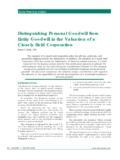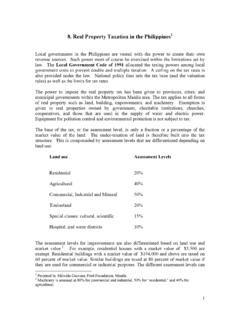Transcription of Estimating costs of small scale - WHO
1 7 1 2 Estimating costs of small scale water supply interventions 3 4 5 6 7 8 9 10 11 12 13 14 15 16 17 18 19 20 21 22 23 24 25 26 27 28 29 30 31 32 33 Paul Jagals, Luuk Rietveld INTRODUCTION Within the scope of this Guide, the main objective of this chapter is to explain a basic approach to Estimating financial costs of installing, maintaining and operating a small scale drinking water supply. After assigning shadow prices to certain costs as appropriate, the outcome of such an estimate can then be used, with the estimates of the total benefits derived from water improvements, to select the best improvement or intervention for a given target group in the context of their livelihood patterns, by comparing rates of return.
2 Costing is one step in the economic assessment of water supply projects and an economic assessment is one part of the full set of information (economic, environmental, health, social, technical assessments and feasibility studies) likely to be used by decision makers in selecting the specifications of the system to implement. In the context of this chapter, the costing method proposed is not intended to provide guidance on full economic valuation of the costs , but rather to provide a financial input into a cost -effectiveness or social cost -benefit analysis of small scale water supply improvements. In a broader sense, costing is an essential element of any economic analysis that may involve modifying financial costs through the assignment of shadow prices to reflect true economic value.
3 At this point in the process, the aim is to identify the financial costs . The description of the costing method in this chapter therefore aims at providing an incremental price in present-day monetary terms (year zero) of water supply technology providing water to a community against which the derived benefits could be measured, so that informed decisions can be made. Information on full economic costing can be found in the WHO publication, Costing Improved Water Supply Systems for Low-income Communities, A Practical Manual, developed by the Department of Econometrics (DE), Faculty of Economic and Social Sciences, University of Geneva (UNIGE) (Carlevaro and Gonzalez 2008).
4 The present Guide is describes the method of social cost -benefit analysis for use at a national level (though sensitive to local livelihood patterns), with the intention that it can be used by non-specialists and specialists alike. So to keep the presentation accessible to all readers, costing of items that are incurred for activities at national level or are indirect outcomes at national or local level are not dealt with in this chapter. These are costs such as external environmental costs , which arise out of local environmental damage or protection, opportunity costs which value the forgone benefits of diverting raw water from productive activities like agriculture (both with significant livelihood implications), to non-productive ones like basic domestic uses, and depletion premiums which value the loss of water supplies from difficult-to-replenish sources, or a share of overhead costs that are needed to run national regulatory and laboratory facilities.
5 34 35 36 37 38 39 40 41 42 43 44 45 46 47 48 49 50 51 52 53 54 55 56 57 58 59 60 61 62 63 64 65 66 67 68 69 70 71 72 73 74 The approach followed in this chapter to estimate the use costs of a water supply intervention such as costs for construction, operation, maintenance, direct administration and overheads. It provides an insight into simple and effective costing that a specialist would use and which a non-specialist at national as well as local level would understand. In practice, costing preferably should be done at the service provider level , a regional water management body or at lower levels, a district authority. The costing could, depending on local capabilities, also be done by the end-user target group or a local NGO.
6 Costing a system locally implies that a water service provider a district authority, or a local user group, decides to invest in improved infrastructure ( , storage and treatment facilities and a distribution network). After constructing and activating the system, the service provider then continues to spend money on the system for operation, maintenance, future rehabilitation, administration, training, promotion and education ( energy and chemicals use), and has to make sure that these expenses are covered by some form of income (standing charges, consumption rates or subsidy). The main objective of the service provider might not be to make a profit, but to provide an economically efficient water service that can also provide benefits in improving the target group s livelihoods.
7 The purpose of a cost estimate in this situation is therefore to assist decision makers responsible for the provision of services with a reliable financial value for providing improved drinking water supply technologies. Chapter 6 describes the differences in quantities or quality of services that characterize small water system technologies. A useful characteristic of small systems is that they can allow for incremental improvement as the target group s needs change over time, perhaps as a result of population growth or move from standpipe to in-house provision. This may lead to a decision to initially choose the most affordable system (least- cost system) with the intention to incrementally adapt the system s capacity to fit the needs or financial capabilities of a growing population.
8 A practical costing approach must allow for this incremental costing as well. 75 76 77 78 79 80 81 82 83 84 85 86 87 88 89 90 91 92 93 94 95 96 97 98 99 100 101 102 103 104 105 106 107 108 109 110 111 112 113 114 115 This chapter discusses the methods and procedures for costing a small water system in three sections. Firstly, the implications of installing a small water system intervention are addressed, be it in the form of putting in a system where there wasn't one before, or upgrading an existing system. Secondly, a brief discussion follows on the various types of financial costs that will be encountered in the process of costing a small water system, and lastly a simplified costing approach is presented to reliably estimate a pattern of costs of systems that allows for costing across time should a system be incrementally adapted.
9 IMPLICATIONS OF COSTING A small WATER SYSTEM INTERVENTION The local costing an intervention system may be done for a new system or for upgrading an existing water supply system to a more sophisticated system. Costing a new system for an area where there is none at first might be quite complicated as it takes place in the early planning stages before the actual construction begins to take shape. Especially costing of the initial stage of a project to install a water system will potentially have large inaccuracies. One reason for this is that relatively little is known during the initial stage (configuration of the treatment scheme, specific construction demands, and local conditions).
10 Another reason is that many things can and will change during subsequent designs. This all requires great understanding and integration of three critical aspects the service provider must have a good idea of what type of intervention ( system) might potentially be installed the intervention types in Chapter 6 will provide a good idea. With this in mind, the layout of the system must be determined (relative positions and elevations of source, storage and pipe network configuration) and then the elements of the potential system must be sized. Only then can the costing of the intended system commence. While costing can be done in great detail to cover for these uncertainties, this will require a high level of collaboration between service providers and engineering planners.
















